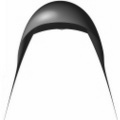The Geometric Cauchy Problem for Pseudospherical Surfaces
Provided that the data is not characteristic for the associated hyperbolic PDE (which holds generically), a unique pseudospherical surface is constructed from a prescribed curve with surface normal prescribed along the curve. If one takes the curve's own normal $n$ from the Frenet frame $(t,n,b)$, one has a unique pseudosperical surface containing the given curve as a geodesic. This geodesic will be a principal curve on the surface if and only if the curve is planar, as is the case in the examples here.
In the reference below, we give explicit formulae for the so-called potentials needed to compute the solutions using a generalized d'Alembert method. This can be implemented numerically to produce images of the solution surface.
More examples can be computed with the numerical implementation code ksurf found here.
References:
- D. Brander and M. Svensson. "The geometric Cauchy problem for surfaces with Lorentzian harmonic Gauss maps", J. Differential Geom. 93, (2013), 37-66. (Preprint here).



